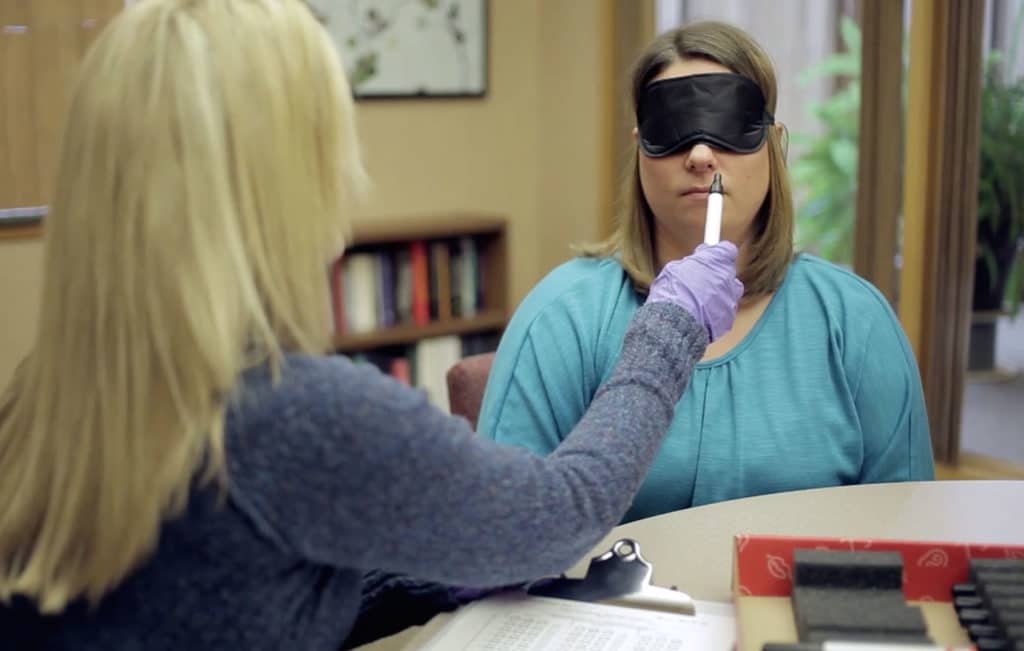By Erin Alessandroni and Janissa Delzo
“I’m going to hand you one of these sticks,” Allison Weiss, a research coordinator at the Penn Memory Center (PMC), told a patient. “What does it smell like: lemon, blueberry, mango, or orange*?”
“It’s hard to tell,” the 82-year-old man with mild cognitive impairment replied.
After wafting the stick back and forth under his nose for about 10 seconds, he answered with uncertainty: “smells like a little orange.”
He went on to sniff 15 more sticks, “getting almost none of the smells right,” Weiss said.
To those with an unimpaired sense of smell, distinguishing among the aforementioned artificial odors is likely an easy task. But for individuals with Alzheimer’s and other neurodegenerative diseases, impaired olfactory function is common.
“Cherry, banana, walnut, or peach*?” Weiss asked, as she handed over another stick.
“A little cherry,” he replied, again with doubt.
In order to assess a person’s sense of smell, researchers commonly use a test called the “Sniffin’ Sticks Odor Identification Test (SS-OIT)”. The kit includes 16 white pen-like sticks with removable blue caps. Underneath the caps are what resemble felt-tip markers, each with a distinct scent. A patient is exposed to the sticks one at a time and are instructed to identify its odor from a choice of four options. For example: honey, vanilla, chocolate, or cinnamon; and, mustard, gum, menthol or turpentine.
To properly test for impairments in olfactory function, researchers need to know what the baseline, or norm, is for cognitively intact older adults. In early 2018, no norms for older adults in the United States existed.
In a new study, published in the Archives of Clinical Psychology, PMC’s David Wolk, MD, Dawn Mechanic-Hamilton, PhD, and Kayci Vickers joined other researchers to establish norms. Dr. Wolk is PMC co-director, Dr. Mechanic-Hamilton is director of Cognitive Fitness programs and neuropsychological services, and Vickers was a neuropsychology practicum student working with Dr. Mechanic-Hamilton.
“The idea is we want to see how good people are at labeling odors because we know in aging, our ability to do so will increase in time sort of naturally. But in neurodegenerative diseases it decreases even more,” Dr. Mechanic-Hamilton said. “We’re using it as a way to get more information on whether or not this person has a sensory deficit that’s out of proportion of what we expected, based on age.”
The research team gave the SS-OIT to 226 cognitively normal adults, all of whom are enrolled in either the PMC’s Aging Brain Cohort (ABC) Study or involved with the Clinical Core of the Alzheimer’s Disease Core Center at the University of Pennsylvania. Each participant received a score, 0-16, based on how many odors they correctly identified.
Results revealed that age at the time of testing was a significant predictor of SS-OIT scores, while sex and education were not.
As with all research, there are limitations to consider when interpreting results. For example, the participants had a relatively high education level which may limit the generalizability of the findings, as the study authors note in their paper. Additionally, the authors acknowledge that their sample consisted primarily of Caucasians and African-Americans living in the United States, which limits generalizability to other racial and cultural groups.
Although future study populations should be more inclusive, Dr. Mechanic-Hamilton notes that their study is one step forward in using SS-OIT more broadly.
“The point of putting the paper out there was to give clinicians something to use in clinical practice. And the more we can get that information out there, the more likely people might use Sniffin’ Sticks,” said Dr. Mechanic-Hamilton.
Since publishing the study, she has gone on to use SS-OIT in a clinical setting, rather than solely in research.
“I feel like I can make a comparison and feel more confident,” said Dr. Mechanic-Hamilton. “If you don’t have anything to compare the results to, then it’s really hard to use Sniffin’ Sticks.”
*The stimuli labels have been altered in order to protect test security.

